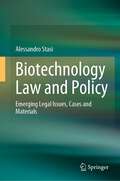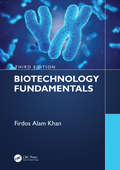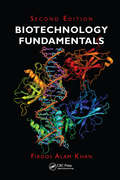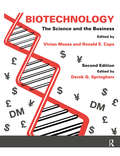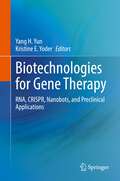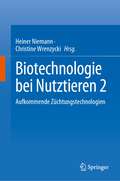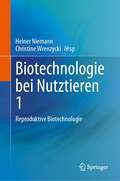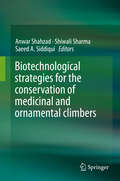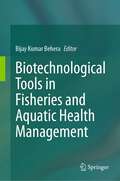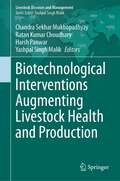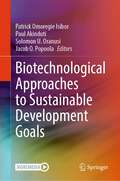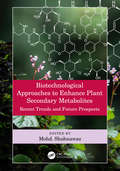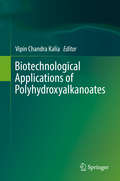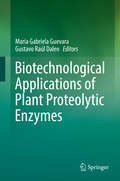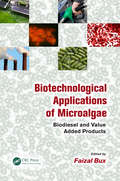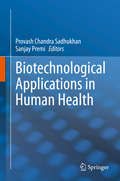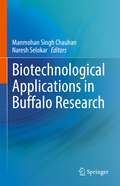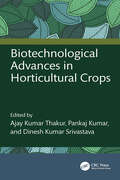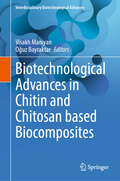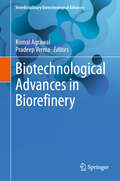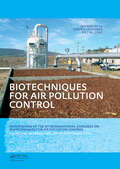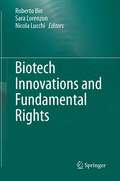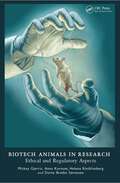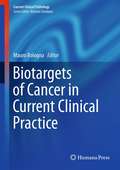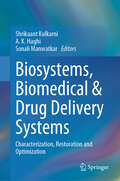- Table View
- List View
Biotechnology Law and Policy: Emerging Legal Issues, Cases and Materials
by Alessandro StasiThis book covers an extensive range of issues raised by biotechnological advancements from a regulatory perspective. Written in a clear and readable style, its main objective is to give readers an idea of the relationship between biotechnology and law. Biotechnology advancements and their ethical, moral, economic, and social implications in different fields and the consequential normative demands on the law are crucial to this book. The chapters cover a multitude of themes and some of the most important legal issues arising in relation to biotechnology, including the historical development of a legal framework sufficient to protect public safety, the current biotechnology regulatory system, and the rules directing the primary agencies that regulate the products of biotechnology, namely the US Food and Drug Administration, the US Department of Agriculture, and the US Environmental Protection Agency, patents and IP rights in biotechnology, the regulation of human genome editing and its impact on health research, law and emerging genome editing technologies from recombinant DNA to CRISPR/Cas9, the development of legal principles to protect property rights in the human body and allow the efficient use of human tissue, organs, DNA, and cell-lines in medical research, and legal issues arising from the use of genetic engineered plants and animals.Presenting arguments that have been drawn from careful examination of various international documents and decisions made by legal institutions and judicial bodies, this book would be a valuable read for practitioners as well as academics of biotechnology law.
Biotechnology Fundamentals Third Edition
by Firdos Alam KhanAfter successful launching of first and second editions of Biotechnology Fundamentals, we thought let us find out the feedbacks from our esteemed readers, faculty members, and students about their experiences and after receiving their suggestions and recommendation we thought it would be great idea to write 3rd edition of the book. Being a teacher of biotechnology, I always wanted a book which covers all aspects of biotechnology, right from basics to applied and industrial levels. In our previous editions, we have included all topics of biotechnology which are important and fundamentals for students learning. One of the important highlights of the book that it has dedicated chapter for the career aspects of biotechnology and you may agree that many students eager to know what are career prospects they have in biotechnology. There are a great number of textbooks available that deal with molecular biotechnology, microbial biotechnology, industrial biotechnology, agricultural biotechnology, medical biotechnology, or animal biotechnology independently; however, there is not a single book available that deals with all aspects of biotechnology in one book. Today the field of biotechnology is moving with lightening speed. It becomes very important to keep track of all those new information which affect the biotechnology field directly or indirectly. In this book, I have tried to include all the topics which are directly or indirectly related to fields of biotechnology. The book discusses both conventional and modern aspects of biotechnology with suitable examples and gives the impression that the field of biotechnology is there for ages with different names; you may call them plant breeding, cheese making, in vitro fertilization, alcohol fermentation is all the fruits of biotechnology. The primary aim of this book is to help the students to learn biotechnology with classical and modern approaches and take them from basic information to complex topics. There is a total of 21 chapters in this textbook covering topics ranging from an introduction to biotechnology, genes to genomics, protein to proteomics, recombinant DNA technology, microbial biotechnology, agricultural biotechnology, animal biotechnology, environmental biotechnology, medical biotechnology, nanobiotechnology, product development in biotechnology, industrial biotechnology, forensic science, regenerative medicine, biosimialars, synthetic biology, biomedical engineering, computational biology, ethics in biotechnology, careers in biotechnology, and laboratory tutorials. All chapters begin with a brief summary followed by text with suitable examples. Each chapter illustrated by simple line diagrams, pictures, and tables. Each chapter concludes with a question session, assignment, and field trip information. I have included laboratory tutorials as a separate chapter to expose the students to various laboratory techniques and laboratory protocols. This practical information would be an added advantage to the students while they learn the theoretical aspects of biotechnology.
Biotechnology Fundamentals
by Firdos Alam KhanA single source reference covering every aspect of biotechnology, Biotechnology Fundamentals, Second Edition breaks down the basic fundamentals of this discipline, and highlights both conventional and modern approaches unique to the industry. In addition to recent advances and updates relevant to the first edition, the revised work also covers ethics in biotechnology and discusses career possibilities in this growing field. The book begins with a basic introduction of biotechnology, moves on to more complex topics, and provides relevant examples along the way. Each chapter begins with a brief summary, is illustrated by simple line diagrams, pictures, and tables, and ends with a question session, an assignment, and field trip information. The author also discusses the connection between plant breeding, cheese making, in vitro fertilization, alcohol fermentation, and biotechnology. Comprised of 15 chapters, this seminal work offers in-depth coverage of topics that include: Genes and Genomics Proteins and Proteomics Recombinant DNA Technology Microbial Biotechnology Agricultural Biotechnology Animal Biotechnology Environmental Biotechnology Medical Biotechnology Nanobiotechnology Product Development in Biotechnology Industrial Biotechnology Ethics in Biotechnology Careers in Biotechnology Laboratory Tutorials Biotechnology Fundamentals, Second Edition provides a complete introduction of biotechnology to students taking biotechnology or life science courses and offers a detailed overview of the fundamentals to anyone in need of comprehensive information on the subject.
Biotechnology - The Science and the Business
by Vivian Moses Ronald E. Cape Derek G. SpringhamBiotechnology has not stood still since 1991 when the first edition of Biotechnology - The Science and the Business was published. It was the first book to treat the science and business of technology as an integrated subject and was well received by both students and business professionals. All chapters in this second edition have been updated and revised and some new chapters have been introduced, including one on the use of molecular genetic techniques in forensic science. Experts in the field discuss a range of biotechnologies, including pesticides, the flavor and fragrance industry, oil production, fermentation and protein engineering. On the business side, subjects include managing, financing, and regulation of biotechnology. Some knowledge of the science behind the technologies is assumed, as well as a layperson's view of buying and selling. As with the first edition, it is expected that this book will be of interest to biotechnology undergraduates, postgraduates and those working in the industry, along with students of business, economics, intellectual property law and communications.
Biotechnologies for Gene Therapy: RNA, CRISPR, Nanobots, and Preclinical Applications
by Yang H. Yun Kristine E. YoderThe purpose of this book is to highlight some of latest developments and applications of CRISPR, RNA, and DNA to treat diseases ranging from cancers to cardiovascular and degenerative disorders. It also features innovations of the delivery methods for nucleic acids ranging from nanodevices made from DNA and pseudo amino acids to viral vectors. This is an ideal book for academics, clinicians, and students interested in gene therapy.
Biotechnologie bei Nutztieren 2: Aufkommende Züchtungstechnologien
by Heiner Niemann Christine WrenzyckiDieses zweibändige Lehrbuch bietet einen umfassenden Überblick über das weite Feld der Tierbiotechnologie mit besonderem Schwerpunkt auf der Reproduktion und Zucht von Nutztieren. Der Leser wird mit einer Vielzahl modernster Technologien und neuer genetischer Instrumente und deren Anwendungen in der Tierproduktion vertraut gemacht. Außerdem werden ethische und rechtliche Aspekte der Tierbiotechnologie erörtert und neue Trends und Entwicklungen auf diesem Gebiet kritisch bewertet. Das zweibändige Werk ist ein Muss für Doktoranden, fortgeschrittene Studenten und Forscher auf dem Gebiet der Veterinärmedizin, Genetik und Tierbiotechnologie.Dieser zweite Band ist den genetischen Werkzeugen der Tierbiotechnologie gewidmet, wie dem somatischen Klonen, transgenen Technologien und der Anwendung von Stammzellen in der Tierzucht. Auch ethische und rechtliche Aspekte werden erörtert.
Biotechnologie bei Nutztieren 1: Reproduktive Biotechnologie
by Heiner Niemann Christine WrenzyckiDieses zweibändige Lehrbuch bietet einen umfassenden Überblick über das weite Feld der Tierbiotechnologie mit besonderem Schwerpunkt auf der Reproduktion und Zucht von Nutztieren. Der Leser wird mit einer Vielzahl modernster Technologien und neuer genetischer Instrumente und deren Anwendungen in der Tierproduktion vertraut gemacht. Außerdem werden ethische und rechtliche Aspekte der Tierbiotechnologie erörtert und neue Trends und Entwicklungen auf diesem Gebiet kritisch bewertet. Das zweibändige Werk ist ein Muss für Doktoranden, fortgeschrittene Studenten und Forscher auf dem Gebiet der Veterinärmedizin, Genetik und Tierbiotechnologie.Dieser erste Band befasst sich hauptsächlich mit künstlicher Befruchtung, Embryotransfertechnologien bei verschiedenen Tierarten und der Kryokonservierung von Eizellen und Embryonen.
Biotechnological strategies for the conservation of medicinal and ornamental climbers
by Anwar Shahzad Shiwali Sharma Saeed A. SiddiquiThe book provides an overview on adoption of biotechnological approaches for the conservation, micropropagation, synseed production of various medicinal and ornamental climbers. The work includes a brief chapter on evolution and diversification of climbers. Other chapters give insights on protocols for in vitro propagation and synseed production of selected threatened medicinal and ornamental climbers. Informative chapter on the production of bioactive compound and their enhancement through genetic transformation and elicitation have been incorporated to cover latest advancement in the field of plant biotechnology. This book also explores the use of molecular marker technique for the desired improvement/magnification of medicinal and aesthetic value of climbing plants.
Biotechnological Tools in Fisheries and Aquatic Health Management
by Bijay Kumar BeheraThis edited book is focused on SDG 14: life below water. This book covers all aspects of fish biotechnology and health management. A detailed description is provided of CRISPR Cas9 technology application in the development of superior variety of fish with better growth, disease resistance, etc., accompanied by numerous helpful photographs and schematic diagrams. In addition, recent developments in nanotechnology and its application in fisheries production enhancement have been discussed. Further, topics includes, probiotics, immunostimulants, fish genetic markers, bioremediation, metagenomics, transgenerational immune priming, application of cell culture in fisheries and nano-biosensor application on fish disease diagnosis, pollution monitoring, etc. are provided in details. . The book is helpful for researchers, teachers, students, farmers, and entrepreneurs in utilizing the knowledge on recent advancements in different aspects of fish genetics and biotechnology for future research and aquaculture production enhancement.
Biotechnological Interventions Augmenting Livestock Health and Production (Livestock Diseases and Management)
by Chandra Sekhar Mukhopadhyay Ratan Kumar Choudhary Yashpal Singh Malik Harsh PanwarThis book comprehensively discusses the applications of molecular genetics, functional and structural genomics, and proteomics vis-a-vis bioinformatics, artificial intelligence, and robotics in livestock healthfulness and productivity. It reviews the biotechnological approaches in veterinary sciences for increasing productivity and resistance to disease. The book emphasizes the approaches based on artificial intelligence to analyze the data collected on animals, pathogens, and their environment. It underscores artificial intelligence applications in disease diagnosis, epidemiological studies, and detecting biological phenomena, including heat-detection, pregnancy, docility, and infections. Further, the book examines the genomics and proteomics approaches for understanding the gut microbiota and the role of pathogen-host interactions in animal health and disease. Lastly, it explores both pathogenic and non-pathogenic microbial transfer between humans, animals, and the environment across one health spectrum.
Biotechnological Approaches to Sustainable Development Goals
by Solomon U. Oranusi Patrick Omoregie Isibor Paul Akinduti Jacob O. PopoolaBiotechnological Approaches to Sustainable Development Goals presents selected contributions from the 2022 International Biotechnology Conference Exhibition and Workshop (IBCEW) that cover techniques, current trends, and cutting-edge biotechnological tools for achieving sustainable development goals (SDGs). The authors explore recent advances that solve challenges related to sustainable agriculture, climate change, prevention and control of pandemics, biotechnology for a sustainable economy, and biotechnological industries and SDGs. The IBCEW aims to share knowledge, experiences, and ideas among scientists, academics, students, industry representatives, and other professionals interested in biotechnology and attaining SDGs for development in Nigeria, Africa, and globally.
Biotechnological Approaches to Enhance Plant Secondary Metabolites: Recent Trends and Future Prospects
by Mohd. ShahnawazThousands of secondary metabolites are produced by plants to withstand unfavourable environmental conditions and are important molecules for nutraceutical, agro, cosmetic and pharmaceutical industries, etc. Harvesting of plants for the extraction of these important metabolites can threaten the plant germplasm, and various medicinally important plants are at the verge of extinction. Based on need, various methods and strategies were developed and followed by researchers from time to time to save the plant germplasm and produce important secondary metabolites efficiently to meet their growing demands. Biotechnological Approaches to Enhance Plant Secondary Metabolites: Recent Trends and Future Prospects provides a comprehensive introduction and review of state-of-the-art biotechnological tools in this field of research at global level. The methodologies are highlighted by real data examples in both in vitro and in vivo level studies. The book: • Highlights and provides overviews of the synthesis, classification, biological function and medicinal applications of the recent advancements for the enhanced production of novel secondary metabolites in plants • Provides an overview of the role of induced mutation, salinity stress and brassinosteroids impact to increase the secondary metabolic contents in plants and suggests an increase in enzymatic activity in plants could be due to various point mutations, which in turn could play a role at transcriptome levels • Discusses the significant role of endophytes to enhance the contents of plant secondary metabolites • Alternatively, suggests the urgent need to set up the standard operating procedures using hydroponics system of cultivation for significant enhancement of secondary metabolite contents • Enlists various in vitro techniques to enhance plant secondary metabolites contents using plant tissue culture approaches • Provides a systematic overview of state-of-the-art biotechnological tools CRISPER Cas9 and RNAi to enhance the plant secondary metabolite contents • Recommends CRISPER Cas9 technology over RNAi, ZFNs and TALENs because of its relatively simple and high precision method with an easily programmable tool This serves as a reference book for the researchers working in the field of plant secondary metabolites and pharmaceutical industries at global level.
Biotechnological Applications of Polyhydroxyalkanoates
by Vipin Chandra KaliaThis book presents the latest research on the uses of polyhydroxyalkanoates (PHA), introducing readers to these natural, biodegradable polyesters produced by microorganisms, their functions and applications. The individual chapters discuss the various potentials of these bioplastics, which offer an attractive alternative to non-biodegradable plastics. The book also describes the diverse medical and biomedical applications of PHAs, including their use as drug carriers, memory enhancers, and biocontrol agents, and examines their role in creating a more sustainable economy – which is the need of the hour.
Biotechnological Applications of Plant Proteolytic Enzymes
by María Gabriela Guevara Gustavo Raúl DaleoThis book offers an overview of the diverse fields application of proteases (also termed proteolytic enzymes or proteinases), including food science and technology, pharmaceutical industries, and detergent manufacturing, reviewing the advances in the biotechnological application plant proteolytic enzymes over the last decade. In recent years, they have been the focus of renewed attention from the pharmaceutical and biotechnology industries, not only because of their activity on a wide variety of proteins but also because they are active over a range of temperatures and pHs. The main audience of this book are researchers working with plant proteases but also professionals from several industry segments such as food production and pharmaceutical companies.
Biotechnological Applications of Microalgae: Biodiesel and Value-Added Products
by Faizal BuxMicroalgae are an invaluable biomass source with potential uses that could lead to environmental and economic benefits for society. Biotechnological Applications of Microalgae: Biodiesel and Value Added Products presents the latest developments and recent research trends with a focus on potential biotechnologically related uses of microalgae. It gi
Biotechnological Applications in Human Health
by Provash Chandra Sadhukhan Sanjay PremiThis book compiles selected articles presented at the International Conference on Biotechnology & Biological Sciences, BIOSPECTRUM 2017, organized by the Department of Biotechnology, University of Engineering & Management, Kolkata. Focusing on biotechnology-based analysis and intervention to address certain human diseases, the book includes a holistic discourse on disease profiling, molecular level analysis of diseases, and non-invasive medical interventions. It features articles on non-invasive treatment of iron deficiency anemia with iron nanoparticles; novel diagnosis methods based on microarray data; analysis using machine learning techniques like artificial neural network for early detection and treatment of cancer; and drug discovery for preventing the growth of human leukemic cells. Further, the book sheds light on in silico drug design using lipopeptides, and identifying the binding sites for their corresponding ligands. Presenting the concepts of the design of potent and safe antimicrobial compounds to fight multi drug resistant pathogens, it also includes interesting reviews on the design and development of various non-invasive methods, such as multi NIR wavelength probes to identify the risk areas in the diabetic foot at an early stage; and a low-cost cochlear implant prototype designed and developed from commercial off the-shelf components to empower the hearing impaired.The book appeals to students, academics and researchers in a wide range of subject areas, including biotechnology, life sciences, medicine and cancer research.
Biotechnological Applications in Buffalo Research
by Manmohan Singh Chauhan Naresh SelokarThis book comprehensively reviews the advancements in biotechnological applications for the enhanced production and conservations of buffalo (Bubalus bubalis). The book discusses developments in assisted reproduction to improve productivity and the produce novel products for applications to human health and nutrition. The initial chapters of the book discuss the global distribution and domestications of buffalo, and nutritive values of buffalo milk, while the subsequent sections examine the applications of the genome-wide association traits to identify potential genetic variants affecting important economic traits. It identifies predictive biomarkers for postpartum or peripartum diseased-state and presents potential protein biomarkers for the diagnosis of early pregnancy in buffalo. Lastly, it discusses recent scientific developments such as induced pluripotent stem cells, spermatogonial stem cells, somatic cell nuclear transfer, and buffalo as a model for human biomedical research. This book is a useful source to students, academicians, researchers, and policymakers who are involved in buffalo science and industry.
Biotechnological Advances in Horticultural Crops
by Pankaj Kumar Ajay Kumar Thakur Dinesh Kumar SrivastavaThe field of horticultural biotechnology has witnessed remarkable growth in recent years, offering profound insights and innovations that are reshaping agriculture's future. Biotechnological Advances in Horticultural Crops serves as a comprehensive guide to the latest innovations and applications. This meticulously curated volume bridges the gap between fundamental knowledge and cutting-edge advancements. From plant tissue culture to genomic approaches, this book spans a diverse array of topics, catering to a broad audience of students, researchers, and academics.Key Features: In-depth exploration of plant tissue culture and its applications in horticultural crop improvement. Insightful coverage of transgenic approaches in fruit crops, including genetic modifications for enhancing fruit quality, yield, and resistance to pests and diseases. Detailed examination of the application of omics sciences in tropical fruits, opening up new perspectives for crop improvement and sustainable production. Extensive discussion on the potential of in vitro production techniques for underutilized and unconventional horticultural crops. Exploration of sustainable agriculture practices, including the use of beneficial microbes and the scientific validation of natural and organic farming practices. This book is more than just a collection of topics; it’s a gateway to the transformative potential of biotechnology in horticulture. It empowers readers (students, researchers, and academicians) to comprehend and harness these advancements, promoting innovation and sustainability in horticultural crop improvement.
Biotechnological Advances in Chitin and Chitosan based Biocomposites (Interdisciplinary Biotechnological Advances)
by Visakh Maniyan Oğuz BayraktarThis book presents a detailed examination of the recent biotechnological advances in chitin and chitosan-based biocomposites, highlighting their preparation, characterization, and wide-ranging applications. It offers a thorough exploration of how these biopolymers are revolutionizing fields such as tissue engineering, regenerative medicine, and drug delivery, with chapters dedicated to nanocomposites, chitin and chitosan whiskers, and their applications in food packaging, energy, and therapeutics. The chapters cover essential topics such as the biotechnological extraction of chitin from shrimp shells, the preparation and characterization of chitin and chitosan whiskers, and their integration into rubber, thermoplastic, and thermoset blends. The book also investigates the therapeutic potential of chitin and chitosan derivatives, focusing on their roles in drug delivery systems, wound healing, and antimicrobial applications. Additionally, it explores the use of these biopolymers in energy applications, including fuel cell technology and supercapacitor electrode materials. This comprehensive volume is designed for academics, researchers, and students in biochemistry, materials science, and biotechnology. It provides an in-depth understanding of the latest research and practical applications of chitin and chitosan, offering solutions to both fundamental and applied challenges. As a "one-stop" reference, it is an invaluable resource for those seeking to leverage the benefits of biodegradable and biocompatible composites in various scientific and industrial domains.
Biotechnological Advances in Biorefinery (Interdisciplinary Biotechnological Advances)
by Pradeep Verma Komal AgrawalThis book is unique as it will cover the latest technological advancements in the field of biorefinery and how it is a major futuristic component of global biofuel research. Initially, the role of bio-based waste materials, microorganisms, and their bioactive metabolites in biorefinery will be focused. Further, recent advances and emerging topics that are related to industrially important products such as biofuels, hydrogen production will also be elaborated. The book addresses the lack of understanding of recent technological advancement such as life cycle assessment (LCA) and techno-economic assessment (TEA) as well. The systems for biorefineries demand a methodical approach to identifying effects and evaluating their long-term viability. Thus, a futuristic paradigm focusing on in silico studies, will also be incorporated, enabling us to understand the developments and impacts of bio-based materials towards a circular and sustainable economy. Additionally the proposed book will also discuss various strategies such as the analysis of cost-effectiveness, nanotechnology, value sensitive design (VSD) and also emphasize the economic, technical, and environmental aspects that affect their production as well as the future perspective in terms of the market scenario. Thus, the book will provide cumulative information on various dimensions of biorefinery and its role as a major bio-economic industry of the future for researchers, industrialists, entrepreneurs, career starters, and policymakers. The shift towards a bioeconomy not only promises innovative solutions to pressing global challenges but also opens up new avenues for various industries and policymakers. Thus, biorefinery is regarded as a crucial aspect of biobased economy ultimately leading the path towards sustainability.
Biotechniques for Air Pollution Control: Proceedings of the 3rd International Congress on Biotechniques for Air Pollution Control. Delft, The Netherlands, September 28-30, 2009
by Christian Kennes Piet N.L. Lens Jan BartacekEnergy and feedstock materials for the chemical industry show an increasing demand. With constraints related to availability and use of oil, the energy and chemical industry is subject to considerable changes. The need for the use of cheaper and widely available feedstocks, and the development of sustainable and environmentally friendly c
Biotech Innovations and Fundamental Rights
by Nicola Lucchi Roberto Bin Sara LorenzonBiotechnology is a recognized research area that has increasingly advanced into new technologies and modern practices raising several legal, ethical and regulatory issues. The revolutionary speed of biotech innovations has had a significant impact on the protection of the rights of the individual. Fundamental rights provide a framework within which the justification of limitations and restrictions to biotechnology innovations and research results have to be assessed. The legal regulation of scientific research and scientific investigations impact more and more directly on the freedom of research and therapies as well as on the broad diffusion of knowledge. Closely related is also the debated question of the technological manipulation of life and the boundary of scientific knowledge with regard to the topical question of genetic invention patents and their side effects on access to scientific information and health care opportunities. Drawing on expertise from different disciplines, the volume comprises invited papers and plenary presentations given at the conference entitled "Biotech Innovations & Fundamental Rights" that took place on Januray 20-21 2011 at the Department of Juridical Sciences of the University of Ferrara. Each contribution covers a different aspect of the legal and scientific issues involved in regulation of biotechnology. In particular the focus of attention has been given to genetic research, genetic data, freedom of scientific research in genetics and biotech patents.
Biotech Animals in Research: Ethical and Regulatory Aspects
by Mickey GjerrisThis book explores central aspects of genetic modification of animals for scientific purposes in the context technological possibilities, regulatory issues in different regions, animal welfare implications and wider ethical issues exemplified through current theories and frameworks. This discussion of lab animals produced through modern biotechnologies becomes increasingly pressing as CRISPR-Cas9 technology advances rapidly, challenging legal and ethical frameworks all over the world. Such animals are now affordable and readily available to almost every branch of scientific research. This not only raises enormous potential for creating ‘tailored’ models for human diseases but also rubs up against the traditional guiding principles (the 3Rs) for the humane use of animals for scientific experiments and raises wider ethical issues around death, integrity and naturalness. In this book, expert authors from diverse backgrounds in laboratory animal care, animal research, technology and animal rights explore a range of topics, from the science behind biotech research animals and the regulation of their use, to utilitarian, animal rights, virtue ethics and ethics of care, and critical animal studiers' perspectives on the use of these technologies. Whatever your background or role in animal research, this book will challenge and stimulate deeper consideration of the benefits, disadvantages and ethical consequences of the use of biotechnology in the animal laboratory.
Biotargets of Cancer in Current Clinical Practice (Current Clinical Pathology)
by Mauro BolognaBiotargets of Cancer in Current Clinical Practice presents an updated and reasoned review of the current status of knowledge concerning the major cancer types with a special focus on the current biomarkers, genes involved and the potential future targets of innovative therapies. The volume includes for each major cancer type, a comprehensive although concise discussion of epidemiology, affirmed and innovative biomarkers for diagnosis, and descriptions of the relevant genes for prognosis and (individualized) therapy through biotarget-specific new molecular treatments, with the latest information on the validation status of each novel biomarker. Individual chapters are dedicated to the major cancer types, plus a special chapter on metastasis. The present debate on patentability of genetic information applied to diagnostics and therapeutics of cancer is also discussed.
Biosystems, Biomedical & Drug Delivery Systems: Characterization, Restoration and Optimization
by A. K. Haghi Shrikaant Kulkarni Sonali ManwatkarThe book gives an insight into the thorough study and examination of incumbent biosystems, their present status and disruption in their integrity, causes and effects, measures to be taken for their characterization and restoration apart from advances and applications in the field of biosciences, drug design, discovery, bio-systems, biomedical and drug delivery technologies, tools in particular. The book collates information from several disciplines, such as chemistry, biology, material science, engineering, statistics, biomedicine, genetics, etc., as the subject in question is a confluence of many disciplines exhibiting numerous applications such as bioimaging, novel biological agents, synthesis, discovery testing, characterization of drugs right from selecting a suitable precursor to discovering and designing a drug following a correct synthetic route, adoption of computer simulation-based models, AI/ML-based models, application of statistical tools in analyzing and interpreting data, design, multi-functional, and operational drug delivery systems, their bio-compatibility, capacity of carrying and release of drug reproducibly etc. The book is helpful to postgraduate students, research scholars, academicians, and scientists from the pharmaceutical, biotechnology, and chemical engineering domains. The book covers a conceptual understanding of the exploration of drugs in unity with the applications desired, sound bio-system development, and carriers for drug and supplement delivery.
